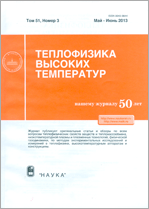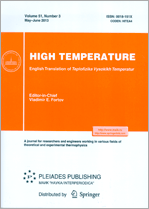|
|
Teplofizika vysokikh temperatur, 2007, Volume 45, Issue 4, Pages 552–556
(Mi tvt1113)
|
 |
|
 |
This article is cited in 1 scientific paper (total in 1 paper)
Heat and Mass Transfer and Physical Gasdynamics
Simulation of turbulent mode of combustion of gas jets
Yu. V. Polezhaev, I. L. Mostinskii, D. A. Gorjainov, G. V. Gabbasova, A. V. Korshunov
Institute for High Temperatures, Russian Academy of Sciences, Moscow
Abstract:
The diffusion mode of combustion of fuel jets in an oxygen-containing atmosphere occurs very widely both in nature and in engineering. In so doing, a glowing flame is formed, whose geometric dimensions define the energy efficiency of combustion of fuel.
The hydrodynamic structure of the flame exhibits a number of differences from the classical jet flows, in particular, from well-studied subsonic turbulent jets [1]. The flames are characterized by a high degree of hydrodynamic instability; however, at the same time, the flame height clearly follows the phenomenon such as the change of laminar mode for turbulent one; by the way, this phenomenon presents a difficult problem for investigation in flows of other types.
The diffusion mode of jet combustion is of further interest because of the presence of "scaling" effect, i.e., the dependence of the relative flame height both on the Reynolds number (which is typical of all flows with laminarto-turbulent transition) and on the dimensionless nozzle diameter $(d_0/d^*)$; in so doing, the threshold value of $d^*$ divides the entire diversity of dimensions into regions with the presence and absence of this effect.
These and other features of burning fuel jets present a serious problem for mathematical simulation of burners and combustors.
The paper contains analysis of a number of relations used in different models of turbulent combustion.
Received: 06.06.2006
Citation:
Yu. V. Polezhaev, I. L. Mostinskii, D. A. Gorjainov, G. V. Gabbasova, A. V. Korshunov, “Simulation of turbulent mode of combustion of gas jets”, TVT, 45:4 (2007), 552–556; High Temperature, 45:4 (2007), 497–501
Linking options:
https://www.mathnet.ru/eng/tvt1113 https://www.mathnet.ru/eng/tvt/v45/i4/p552
|


|





 Contact us:
Contact us: Terms of Use
Terms of Use
 Registration to the website
Registration to the website Logotypes
Logotypes








 Citation in format
Citation in format 
